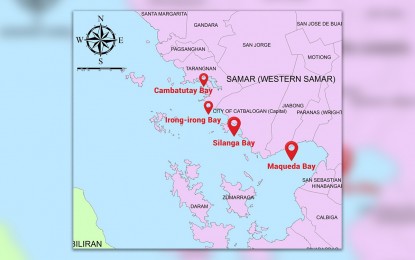
RED BLOOM. The map shows the five bays in Samar province hit by the red tide infestations. Heavy downpour after prolong dry season has triggered the recurrence of the red tide phenomenon in these areas. (Photo courtesy of Bureau of Fisheries and Aquatic Resources)
TACLOBAN CITY -- Heavy downpour after prolong dry season has triggered the recurrence of red tide phenomenon in five bays in Samar province, the Bureau of Fisheries and Aquatic Resources (BFAR) reported on Tuesday.
BFAR Regional Director Juan Albaladejo said in a phone interview the change of weather has contributed to the resurgence of red tide in Samar’s coastal communities known for producing shellfish.
Tagged as red tide positive are San Pedro Bay in Basey and Marabut towns, Maqueda Bay in Jiabong, Silanga Bay in Catbalogan City, Irong-irong Bay in Catbalogan City, and Cambatutay Bay in Tarangnan town. The fisheries bureau raised the red tide alert on July 12.
“We did experience a mild El Niño that warmed the seawater and increased water salinity. Coupled with these rainy episodes, it is very ideal for the blooming. The rain brought down sediments to seawater which fertilize the red tide microorganism to increase its numbers in a short time period,” Albaladejo told the Philippine News Agency (PNA).
The presence of red tide in both shellfish meat and water calls for the prohibition of gathering, trading, and consumption of marine bivalves from identified areas over the possibility of paralytic shellfish poisoning.
BFAR conducts weekly monitoring of seawater in bays hit by red tide in the past, but authorities examine water and meat samples three times weekly for positive areas.
The fisheries bureau advised the public to refrain from eating, harvesting, selling, and buying shellfish products and Acetes sp. (small shrimps) from the affected bays until such time that the shellfish toxicity level has gone down and safe to eat.
Fish caught in these areas are safe for human consumption provided these are fresh, and washed and cooked thoroughly, according to the BFAR advisory.
The most affected in this new spate of red tide phenomenon is Maqueda Bay in Jiabong town where over a thousand fishermen depend on green mussel for livelihood. The town is one of the major suppliers of mussels for the country’s markets.
It also serves as a central trading center from where mussels are shipped to Metro Manila, Davao City, Bicol, Cebu City, and other parts of the country.
The slow seawater current has made the place ideal for mussel farming. The town produces about 200 sacks of green mussels daily with each sack traded at PHP1,200 to PHP1,500.
Red tide is a term used to describe a phenomenon, where the water is discolored by high algal biomass or the concentration of algae. The discoloration may not necessarily be red in color, but it may also appear yellow, brown, green, blue or milky, depending on the organisms involved. (PNA)
